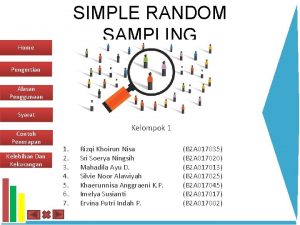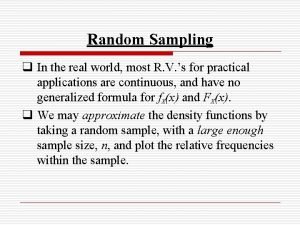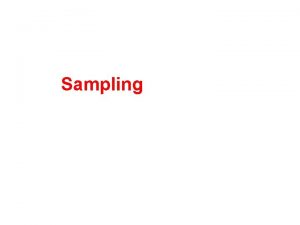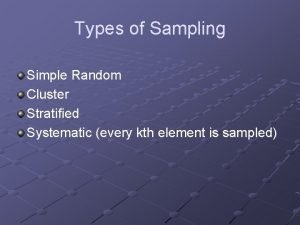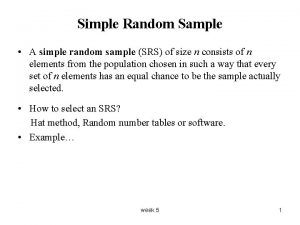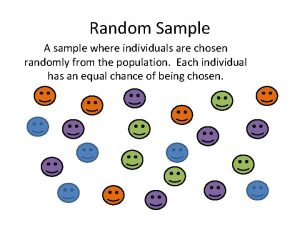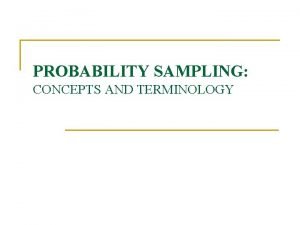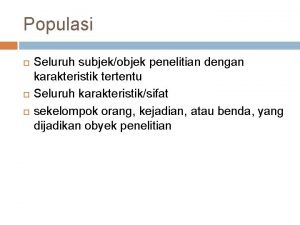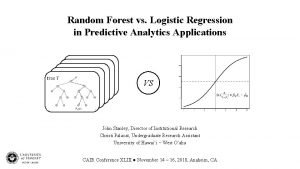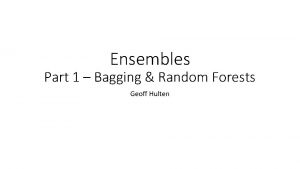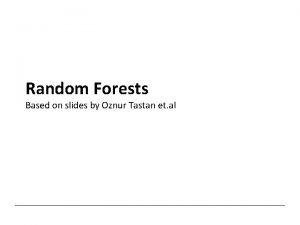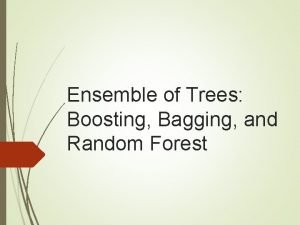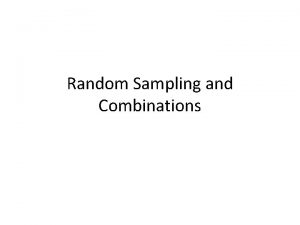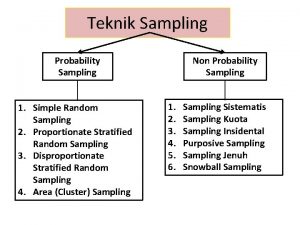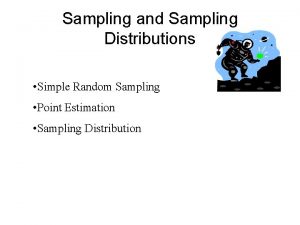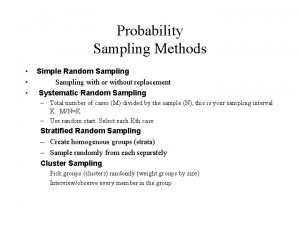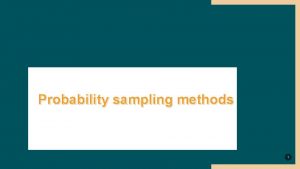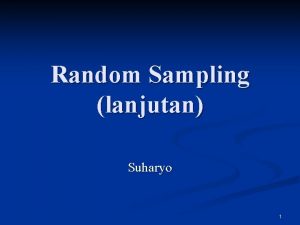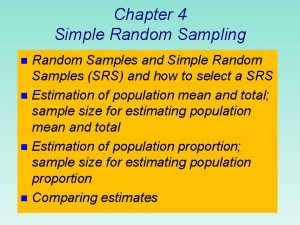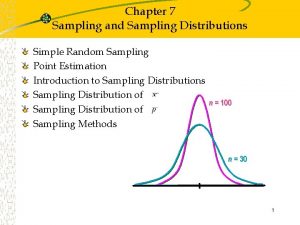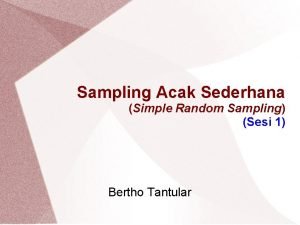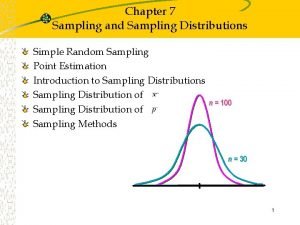FOR 373 Forest Sampling Methods Simple Random Sampling























- Slides: 23

FOR 373: Forest Sampling Methods Simple Random Sampling • What is it? • How to do it? • Why do we use it? • Determining Sample Size Readings: Elzinga Chapter 7

Simple Random Sampling: What is it “In simple random sampling every possible combination of sampling units has an equal and independent chance of being selected” Avery and Burkhart

Simple Random Sampling: What is it This does not mean that each sample has an equal probability of being selected. For example, these stands may have 80% PIPO and 20% ABGR

Simple Random Sampling: What is it A random sample is one in which the selection of a particular sample does not depend on whether another sample has been chosen: Independent Samples

Simple Random Sampling: How to do it Random Number Generation: Assign each square a number and make a random number generator select them. Then sample them in that order.

Simple Random Sampling: Why do we use it Simple Random Sampling is often used to evaluate the variance of a unit when we do not know either what the stand boundaries are or what underlying environmental variables may influence the variability. Simply put: When we do not know enough to stratify the unit and before we can plan a proper sampling design we need to collect some preliminary data

Simple Random Sampling: Why do we use it Therefore, we randomly sample a unit to determine the Coefficient of Variation (CV) and this allows us to calculate how many plots we will need in our inventory

Simple Random Sampling: The two main kinds Two main kinds of simple random sampling are used in forestry: 1. With Replacement 2. Without Replacement

Simple Random Sampling: With Replacement: Each sampling unit is allowed to be sampled as often as it is selected

Simple Random Sampling: Without Replacement: Each sampling unit can only be sampled once and is effectively removed from the population once sampled The majority of forest sampling is done without replacement. However, other disciplines use with replacement methods

Simple Random Sampling: An Example of Wildlife Consider evaluating the abundance of animals purely by sampling the number in visual range at random points These approaches are called mark-recapture methods Recommended Reading: Elzinga et al Chapter 13 (full book)

Simple Random Sampling: An Example of Wildlife The Premise: A sample of animals are caught and tagged (say 70) and then allowed to remix with the population At a subsequent sample: the % of tagged animals re-caught (say 10%) is assumed to represent the % of the tagged to the whole population Total Population = 70/10*100 = 700 ** Class Courtyard Flagging Example

Simple Random Sampling: An Example of Wildlife Mark-Recapture Limitations. Very Time Consuming: To achieve a precision of ± 10% for a population of 200 you need to sample 90% of the population! Sampling Changes the Properties of the Population of Interest: Being there changes the very habitat you wish to observe – Essentially Heisenberg's Uncertainty Principal Recommended Reading: Elzinga et al Chapter 13 (full book)

Simple Random Sampling: An Example of Wildlife Mark-Recapture Limitations: • Tags may be lost • Tagged animals may be less prone to recapture • Tagged animals may be affect its social status or health • Same sub-population may not mix with larger population Recommended Reading: Elzinga et al Chapter 13 (full book)

Simple Random Sampling: Getting Information For both with and without replacement methods, the population mean is calculated using this equation:

Simple Random Sampling: Getting Information The With Replacement (or infinite population) Standard Error: The Without Replacement (or finite population N) Standard Error: The difference is called the finite population term:

Simple Random Sampling: So Why do We Care? To plan ANY forest inventory its needs to be statistically valid while practical. Enough samples must be collected to obtain an estimate of the inventory to a reasonable precision. Too many is a waste. Too few will make the errors to high. The preliminary data from Simple Random Sampling and the standard error allows us to determine exactly how many plots we will need.

Simple Random Sampling: Getting Information Based on this information we can now calculate the number of sampling plots we will need in our inventory: n = samples to estimate mean to ± E t = t-value from students t-test table s = standard deviation from a prior work E = standard error of the mean

Simple Random Sampling: Getting Information Or when using percentage error we could calculate sample size or number of plots by using the following equation: n = samples to estimate mean to ± E t = t-value from students t-test table s = variance from a prior work E = allowable % error

Sampling: How Many Sampling Units t-values table: A Work Through Example Degrees of Freedom = n-1 Need to estimate n to get t-value

Sampling: How Many Sampling Units t-values table: A Work Through Example Let n = 4, then for 80% probability the t-value = 1. 6377

Sampling: How Many Sampling Units t-values table: A Work Through Example We have: n = 4, t-value = 1. 6377 Calculate sample size using E= 10% and a CV of 30 Then you recalculate your degrees of freedom with the new n value until n repeats (changing your tvalue). DF= 23 (t= 1. 3195) DF= 15 (t= 1. 3406)

Sampling: How Many Sampling Units t-values from Excel
 Random assignment vs random sampling
Random assignment vs random sampling Limitations of systematic sampling
Limitations of systematic sampling Stratified sample vs cluster sample
Stratified sample vs cluster sample Cluster random sampling vs stratified
Cluster random sampling vs stratified Convenience sampling images
Convenience sampling images Alasan menggunakan simple random sampling
Alasan menggunakan simple random sampling Consecutive sampling
Consecutive sampling Simple random sampling pros and cons
Simple random sampling pros and cons Simple random sampling real life examples
Simple random sampling real life examples Sampling unit example
Sampling unit example Simple random sampling
Simple random sampling Simple random sampling formula
Simple random sampling formula Random sampling
Random sampling Random assignment vs selection
Random assignment vs selection Random sampling adalah
Random sampling adalah Tabel nomogram harry king
Tabel nomogram harry king Bagging and boosting
Bagging and boosting Survival trees python
Survival trees python Logistic regression in predictive analytics
Logistic regression in predictive analytics Random forest intro
Random forest intro Bagging vs random forest
Bagging vs random forest Random forest slides
Random forest slides Adaboost classifier
Adaboost classifier Jmp random forest
Jmp random forest





